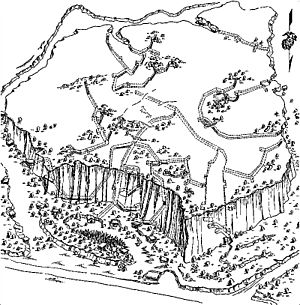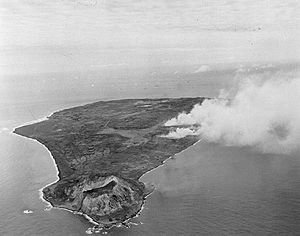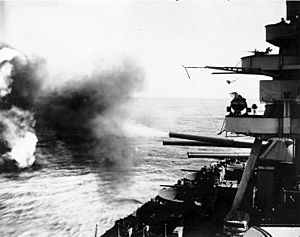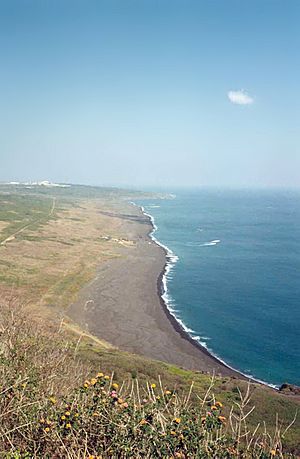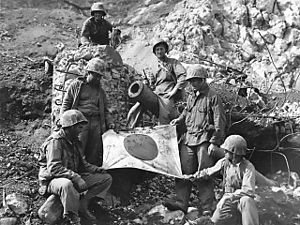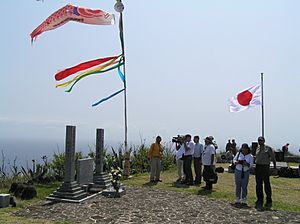Tadamichi Kuribayashi facts for kids
Quick facts for kids
Tadamichi Kuribayashi
|
|
|---|---|
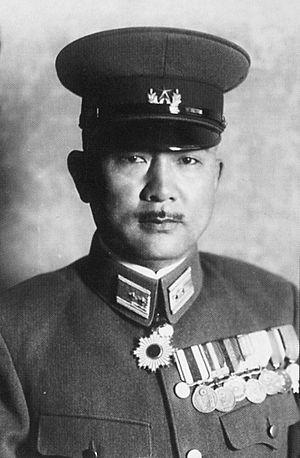
Kuribayashi in 1943
|
|
| Native name |
栗林 忠道
|
| Born | 7 July 1891 Nagano Prefecture, Japan |
| Died | c. 26 March 1945 (aged 53) Iwo Jima, Japan |
| Allegiance | Empire of Japan |
| Service/ |
Imperial Japanese Army |
| Years of service | 1911–1945 |
| Rank | General |
| Unit | 1st Cavalry Brigade 2nd Guards Division 109th Infantry Division |
| Battles/wars | World War II |
| Awards | Grand Cordon of the Order of the Rising Sun (1967; posthumous) Grand Cordon of the Order of the Sacred Treasure Order of the Rising Sun with Gold and Silver Star (2nd class) Order of the Rising Sun, Gold Rays with Neck Ribbon (3rd class) |
| Alma mater | Harvard University |
General Tadamichi Kuribayashi (栗林 忠道, Kuribayashi Tadamichi, 7 July 1891 – c. 26 March 1945) was a general in the Imperial Japanese Army, part-time writer, haiku poet, diplomat, and commanding officer of the Imperial Japanese Army General Staff. He is best known for having been the commander of the Japanese garrison at the battle of Iwo Jima.
Even before the battle, General Kuribayashi insisted upon sharing the hardships of his men. He also refused to permit banzai charges, which he regarded as an unnecessary waste of his men's lives. The United States Marine Corps had expected to capture Iwo Jima in five days, but Kuribayashi and his men held out for 36 days. It is believed that Kuribayashi was killed in action while leading his soldiers in a night-attack on American troops, but his body was never identified by the United States military. U.S. Marine Corps General Holland Smith said of Kuribayashi that "Of all our adversaries in the Pacific, Kuribayashi was the most redoubtable."
Contents
Early life
Tadamichi Kuribayashi was born into a minor samurai family in Hanishina District, Nagano prefecture. According to Kumiko Kakehashi, the Kuribayashi family had lived in the district since the 15th century.
Kuribayashi graduated from Nagano High School in 1911. Although he had originally aspired to be a journalist, Kuribayashi was persuaded by his high school instructors to instead enter the Imperial Japanese Army Academy.
Kuribayashi graduated from the Army Academy's 26th class in 1914, having specialized in cavalry. He continued on to the Army's Cavalry School in 1918. In 1923, he graduated from the 35th class of the Army War College with splendid marks and received a military sabre from the Taisho Emperor. Kuribayashi married Yoshii Kuribayashi (1904–2003) on 8 December of that year. Together they had a son and two daughters (Taro, Yoko and Takako).
Kuribayashi was designated as deputy military attaché to Washington, D.C. in 1928. For two years, Kuribayashi traveled across the United States, conducting extensive military and industrial research. During his time in the U.S., Kuribayashi studied at Harvard University.
After returning to Tokyo, Kuribayashi was promoted to the rank of major and appointed as the first Japanese military attaché to Canada. He was promoted to lieutenant colonel in 1933.
During his services in the Imperial Japanese Army General Staff in Tokyo from 1933 to 1937, he wrote lyrics for several martial songs. In 1940 Kuribayashi was promoted to major general.
During the lead up to the Attack on Pearl Harbor, Kuribayashi is known to have repeatedly told his family, "America is the last country in the world Japan should fight."
Pacific War
In December 1941, Kuribayashi was ordered into the field as the Chief of Staff of the Japanese 23rd Army, commanded by Takashi Sakai, in the Invasion of Hong Kong. The 23rd Army's occupation caused horrible massacres in Hong Kong. After the war, the 23rd Army's commander Takashi Sakai was accused of war crimes at the Chinese War Crimes Military Tribunal, found guilty and executed by firing squad on 30 September 1946. According to a former subordinate, General Kuribayashi regularly visited wounded enlisted men in the hospital, which was virtually unheard of for an officer of the General Staff.
In 1943, he was promoted to lieutenant general, and reassigned to be commander of the 2nd Imperial Guards Division, which was primarily a reserve and training division. On 27 May 1944, he became commander of the IJA 109th Division.
Just two weeks later, on 8 June 1944, he received orders signed by Prime Minister Hideki Tojo to defend the strategically located island of Iwo Jima in the Bonin Islands chain. According to Yoshii Kuribayashi, her husband said upon receiving the orders that it was unlikely even for his ashes to return from Iwo Jima.
..... General Kuribayashi was known for having expressed the belief that Japan's war against the United States was a no win situation and needed to be ended via a negotiated peace. In the eyes of the ultra-nationalists in the General Staff and in Tojo's cabinet, this had allegedly caused Kuribayashi to be seen as a defeatist.
He was accorded the honor of a personal audience with Emperor Hirohito on the eve of his departure. In a subsequent letter to Yoshii and their children, the General made no mention of meeting the Emperor. He instead expressed regret for failing to fix the draft in the kitchen of their home. He included a detailed diagram so that his son, Taro Kuribayashi would be able to complete the repair and prevent the family from catching cold.
Planning for the Battle of Iwo Jima
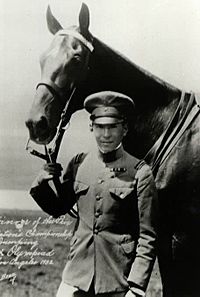
On 19 June 1944, General Kuribayashi stepped off a plane on Iwo Jima's Chidori airstrip. Meanwhile, the island's garrison was busy digging trenches on the beach. Kuribayashi made a careful survey of the island and ordered his men to construct defenses further inland. Deciding not to seriously contest the projected beach landings, Kuribayashi decreed that the defense of Iwo Jima would be fought almost entirely from underground. His men honeycombed the island with more than 18 kilometers (11 mi) of tunnels, 5,000 caves, and pillboxes.
Kuribayashi recognized that he would not be able to hold Iwo Jima against the overwhelming military forces of the United States. He knew, however, that the loss of Iwo Jima would place all of Japan within range of American strategic bombers. Therefore, he planned a campaign of attrition, by which he hoped to delay the bombing of Japanese civilians and to force the United States Government to reconsider the possible invasion of Japanese home islands.
Long before the Americans landed, however, Gen. Kuribayashi fully expected to die on Iwo Jima.
The Japanese defenders include Private Takeo Abe, who survived the battle and spent the remainder of his life repatriating the remains of his comrades.
In order to prepare his soldiers for an unconventional style of fighting, Kuribayashi composed six "Courageous Battle Vows" which were widely reproduced and distributed among his men.
Kuribayashi also composed a set of instructions to the soldiers of the "Courage Division." They read as follows:
Battle of Iwo Jima
On 19 February 1945, the United States Marine Corps landed its first men on the southern shore of the island. In a radically different approach, American officers and men were first allowed to land unmolested and then shelled and machine gunned from underground bunkers. As night fell, Marine Corps General Holland Smith studied reports aboard the command ship Eldorado. He was especially stunned that Kuribayashi's men had never attempted a banzai charge.
Meanwhile, General Kuribayashi had herded the remnants of the Iwo Jima garrison into a heavily fortified ravine which the Marine Corps dubbed, "The Gorge."
Marine Corps General Graves Erskine sent Japanese American Marines and captured Japanese soldiers to try to persuade Kuribayashi and his men to surrender.
On the evening of 23 March 1945, Kuribayashi radioed a last message to Major Hori, "All officers and men of Chichi Jima – goodbye from Iwo." Major Hori later recalled, "I tried to communicate with them for three days after that, but in the end I received no answer."
On 17 March 1945, the General had sent his farewell message to Imperial Headquarters accompanied by three traditional death poems in waka form. All were, according to historian Kumiko Kakehashi, "a subtle protest against the military command that so casually sent men out to die."
He closed the message with three waka poems as follows:
Unable to complete this heavy task for our country
Arrows and bullets all spent, so sad we fall.
But unless I smite the enemy,
My body cannot rot in the field.
Yea, I shall be born again seven times
And grasp the sword in my hand.
When ugly weeds cover this island,
My sole thought shall be the Imperial Land.
Death
The exact circumstances of Kuribayashi's death remain a mystery. It is most likely that he was killed in action in the early morning of 26 March 1945, while leading his surviving soldiers in a three-pronged assault against sleeping Marines and Air Force ground crews. Kuribayashi and his men silently slashed tents, bayoneted sleeping men, and lobbed hand grenades. According to the official United States Marine Corps History, "The Japanese attack on the early morning of 26 March was not a banzai charge, but an excellent plan aiming to cause maximum confusion and destruction." The assault climaxed in a hand-to-hand battle to the death between the men of both armies. The General's body could not be identified afterwards for he had removed all officer's insignia in order to fight as a regular soldier.
According to less credible theories, Kuribayashi is alleged to have committed seppuku at his headquarters in the Gorge.
The General's son, Taro Kuribayashi, interviewed several survivors of the Japanese garrison after the war. As a result, he believes that his father was killed in an artillery barrage during the final assault.
Legacy
The US declared Iwo Jima secure on 26 March 1945, after suffering 26,039 casualties. Only 1,083 of the 22,786 Japanese defenders survived to be captured. A small number of holdouts continued to remain at large, leaving their fortified caves at night in order to steal food from the American garrison. The last two holdouts, Naval machine gunners Yamakage Kufuku and Matsudo Linsoki, surrendered on 6 January 1949.
Yoshii Kuribayashi was only 40 years old when her husband died on Iwo Jima, and she subsequently worked hard to bring up their children without a father. According to their daughter Takako Kuribayashi, "My mother had been brought up as a lady, and even after getting married she had been taken care of by my father. She had never worked in her life before, but she still managed to raise us during the terrible years after the war by doing things like selling cuttlefish out on the street. And more than that, she sent not just my elder brother, but me, a girl, to university."
Many years later, Yoshii Kuribayashi visited Iwo Jima and paid tribute to her fallen husband.
See also
 In Spanish: Tadamichi Kuribayashi para niños
In Spanish: Tadamichi Kuribayashi para niños
- Yoshitaka Shindō – Japanese political figure and grandson of General Kuribayashi.




